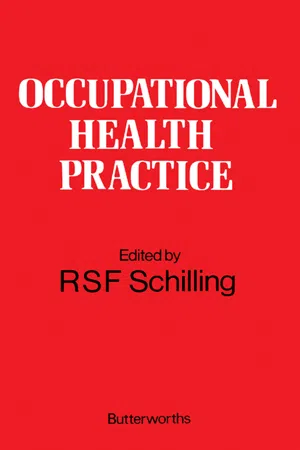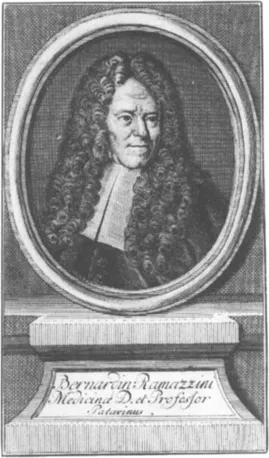![]()
1
Developments in Occupational Health
Publisher Summary
This chapter discusses developments in occupational health. There is a wide variation in the standards of occupational health practice and research in different countries. This brief historical review indicates the factors that appear to be most significant in influencing national policies—humanity of a society, its wealth, the social status of the worker, his/her political organization, and his/her representation in government. Standards are dictated more by the attitudes of management than by statutes. An important factor is the extent to which employers are aware of the economic advantages of providing for the health and safety of their employees. The more serious effects on health that followed the Industrial Revolution were not directly occupational in origin. Family life was disrupted when men moved into new industrial areas, leaving their families behind. This situation encouraged alcoholism and prostitution. There were also epidemics from overcrowding in unsanitary conditions, malnutrition as a result of the change from rural to urban life, and the poverty that followed unemployment caused by fluctuations in the economy.
History offers a stimulus of imagination and understanding which can enrich a man’s life by deeper insights into human behaviour. It is perhaps the greatest humanist medium of our time, educational and cultural.
David Thomson (1969)
Both ancient and modern societies have been slow to recognize and control the health hazards associated with work. Sigerist (1943), the medical historian, tells us that a history of developments in occupational health will help to reveal the factors involved – those that retard and those that accelerate developments, and so enable a modern society to act more intelligently and pave the way into the future.
AGE OF ANTIQUITY
Mining is one of the oldest industries and has always been a hazardous occupation. Conditions in the gold, silver and lead mines of ancient Greece and Egypt have been described and they reveal an almost complete disregard for miners’ health and safety (Rosen, 1943). Since the miner of antiquity was a slave, prisoner or criminal there was no reason to improve his working conditions. Indeed, the reverse was true, because one of the objectives was punishment and there were ample reserves of manpower to replace the injured men. One of the earliest references to the control of hazards is in the second century AD during the Roman period. Miners at that time enveloped themselves in bags and sacks, and used bladders to cover their mouths as a protection against dust inhalation (Legge, 1936).
THE MIDDLE AGES AND RENAISSANCE
The first published observations on miners and their diseases were by Agricola (1494–1555) in De Re Metallica, a treatise on metal mining published in 1556 (translated into English by an engineer, Herbert Hoover, who later became President of the United States) and by Paracelsus (1493–1541) in his monograph on occupational diseases of mine and smelter workers published eleven years later.
During the middle ages, the status of the miner changed. Mining in Central Europe had become a feudal enterprise manned by serf labour which was unskilled and, in the long run, uneconomical. The need for skilled labour led to the emancipation of the miner. The growth of trade created a demand for currency and capital which was filled by increasing the supply of gold and silver from the mines of Central Europe. Mines got deeper and conditions worsened. In 1527 Agricola was appointed official town physician to Joachimstal, a flourishing mining centre in Bohemia. He described the ailments of miners. At that time their mortality from pulmonary diseases was not recorded nor were the causes known, but they would have included deaths from silicosis, tuberculosis, and from lung cancer due to the mining of a radioactive ore in siliceous rock. This mortality must have been high judging by the evidence of Agricola’s statement that ‘in the mines of the Carpathian mountains, women are found who have married seven husbands, all of whom this terrible consumption has carried off to a premature death’. Apart from improvements in ventilation, miners remained without any significant means of protection. However, they organized themselves into societies which provided sickness benefit and funeral expenses, giving them some security and preventing the extremes of social misery (Rosen, 1943). Such improvements as there were followed the changed social status of the miner, and the recognition by outstanding physicians like Agricola and Paracelsus of the extent and severity of occupational disease. Paracelsus based his monograph on his experience as town physician in Villach, Austria, and later as a metallurgist in the metal mines in that area. He remarks: ‘We must also have gold and silver, also other metals, iron, tin, copper, lead and mercury. If we wish to have these, we must risk both life and body in a struggle with many enemies that oppose us’. Paracelsus realized that the increasing risk of occupational disease was a necessary and concomitant result of industrial development.
BERNARDINO RAMAZZINI – FATHER OF OCCUPATIONAL MEDICINE
During the sixteenth and seventeenth centuries mining, metal work and other trades flourished in Italy following the Renaissance which had encouraged the transition from feudalism to capitalism (Bernal, 1969). In 1700, Bernardino Ramazzini (1633–1714) (Figure 1.1), physician and professor of medicine in Modena and Padua, published De Morbis Artificum Diatriba. It was the first systematic study of trade diseases and in it he put together the observations of his predecessors and his own, based on visits to workshops in Modena. Rightly acclaimed the father of occupational medicine, he showed an unusual sympathy for the less fortunate members of society. He was the first to recommend that physicians should enquire about the patient’s occupation (see Chapter 2).
Figure 1.1 Bernardino Ramazzini (1633–1714)
His interest in occupational medicine appears to have been inspired by the opportunities it offered to make new observations as well as his sympathy for the common people. As a physician of that time he was probably unique. ‘I hesitate and wonder whether I shall bring bile to the noses of doctors – they are so particular about being elegant and immaculate – if I invite them to leave the apothecary’s shop which is usually redolent of cinnamon and where they linger as in their own domain, and to come to the latrines.’ Neither his medical colleagues nor the influential people of society had any strong humanitarian sense to inspire them to heed his words, nor at that time was there any economic necessity to protect the life and health of workmen.
However, the eighteenth century brought great technological inventions and laid the foundations of modern society with its factory system which exposed workers of all grades to the pressures of increasing production and the associated physical and psycho-social hazards of work.
THE INDUSTRIAL REVOLUTION
From the earliest times, India was the home of the cotton industry and for centuries the Hindu’s skill in making textiles was the main source of his country’s wealth. In the tenth century, cotton was introduced by the Moors into Spain, and later its production spread to Europe. Towards the end of the sixteenth century, it reached England with the arrival of religious refugees from Antwerp. Spinning and weaving thrived as a cottage industry until the latter half of the eighteenth century when mechanization transferred the making of textiles from the people’s homes to the new factories; later the factory system spread to other industries in Europe and North America. This change in method of manufacture so unsettled the traditional routine of family and community life that it became known as the Industrial Revolution. There were several forces which led to this fundamental change in the methods of manufacture. Science and technology were developing the use of steam for motive power. There were large increases in the population of England and Wales. The breakdown of the strong central government of the Tudors and Stuarts, which had attempted to keep society geographically and socially static, allowed people to move from the country to the towns to man the new factories. From her commercial and banking enterprises overseas, Britain had accumulated the financial resources to build new factories and the towns to house the people.
Forces which are not dissimilar from those preceding the Industrial Revolution have enabled rapid industrialization to take place in developing countries. Such forces are the development of hydroelectric and other forms of power, increases in population, the end of colonialism, and the financial and technical assistance made available to them by developed countries.
EFFECTS OF INDUSTRIALIZATION ON COMMUNITY HEALTH
The more serious effects on health which followed the Industrial Revolution were not directly occupational in origin. Family life was disrupted when men moved into new industrial areas leaving their families behind. This was a situation which encouraged alcoholism and prostitution. There were also epidemics from overcrowding in insanitary conditions, malnutrition as a result of the change from peasant to town life, and the poverty which followed unemployment caused by fluctuations in the economy.
Another change was in habitation of work people. They had moved from the countryside of rural England to the squalor and ugliness of the new industrial towns in Northern England. The Hammonds (1917) described them as ‘bare and desolate places without colour, air or laughter where man, woman and child ate, worked and slept’. There were a few sympathetic employers like Robert Owen (1771–1858) and Michael Sadler (1780–1833) who provided good working and housing conditions for their employees. But poor housing, overcrowding and lack of sanitation caused by the concentration of an expanding population around the new factories led to the development of the public health services which were designed to control disease and improve the health of these communities.
The health problems arising from industrial progress in tropical countries today are, in many aspects, similar to those in the West during industrialization in the nineteenth century. In addition, developing countries have to face major threats of disease which are not directly related to work. This situation demands an approach which considers the health of the whole community in relation to the new modes of employment and the changing environment.
EFFECTS OF INDUSTRIALIZATION ON INDIVIDUAL HEALTH
Inside the factories and mines of the nineteenth century the workers were exposed to the specific hazards of occupational disease and injury and the adverse effects of excessively long hours of work.
As manufacturing techniques improved, machines became speedier and more dangerous. Little attention was paid to safety devices and workers were often simple people...

